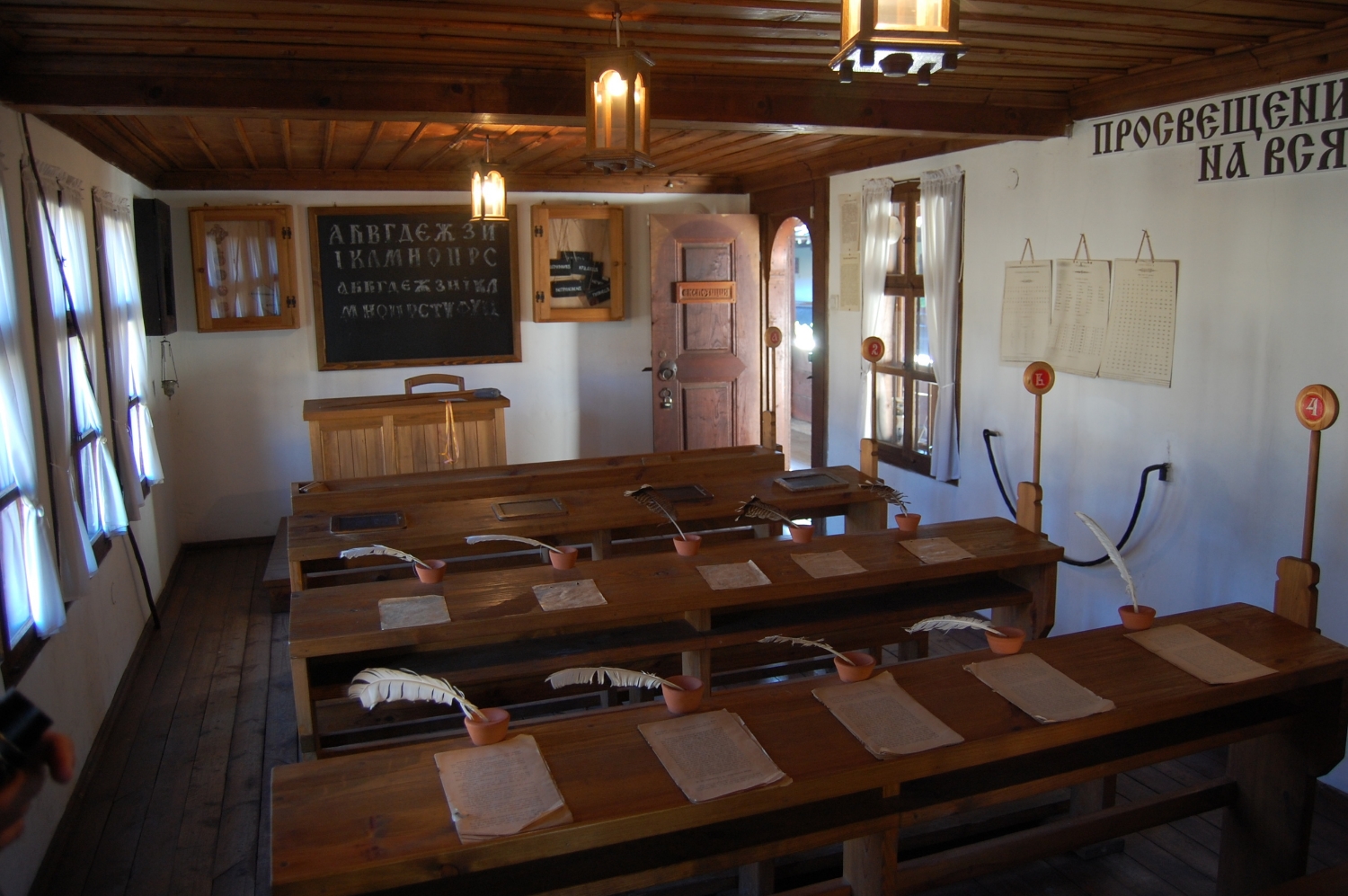And so in the 10th century, John of Rila gave his blessing to Brother Gregory and a handful of monks to start Rila Monastery using the Testament of John of Rila as their guide: follow Jesus, help anyone in need, live democratically, all people are equal, do manual labor, live in harmony. He died a few years later and was quickly made a saint. Within a few centuries, this holy place designed to save men's souls would save their country's heritage.
The entrance gate into Rila Monastery. Photo © Del Weliver
A number of small churches were built in the woods over time, with the building sites gradually moving down the mountain to the present location of Rila Monastery.
The monks went about their church services and provided food and shelter to pilgrims. This holy site became a crossroads for pilgrimages. They received visiting monks and they traveled to other monasteries on paths, roads and rivers. The nearby Struma River runs into the Aegean Sea or northern part of the Mediterranean. Some may have gone to Constantinople or Mount Athos, the center of Orthodox Christianity.
There is so much here; I found the spirituality, history and importance of Rila Monastery overwhelming, even with a knowledgeable guide. To help me understand, I developed a short timeline of people and events that connects 1000 years of Bulgarian history with Rila, for indeed they are very intertwined. Perhaps you will find it helpful, too.
1334 - fortified tower
Armed guards were hired to defend the monastery from bandits who tried to steal gifts given to the monastery. Eventually in 1334 a local feudal lord, Hrelyo Dragovol, built a five story, fortified tower in the center of the present day monastery to protect his family and the monks. A small church was next to the tower. Evidence of stone wall foundations suggest that the whole area was enclosed.
When you enter through newer stone walls 65 feet (20 m) high you can see the medieval tower and the 19th century Nativity of the Virgin Church. The walls are the backs of dormitories begun in 1816.
Hrelyo (Stefan) Dragovol Tower built 1334. Photo © Del Weliver
The Chapel of the Transfiguration is on the top floor with beautiful paintings from Medieval times. You can see the stone work on the outside of the tower that allows the top floor to be larger. From the roof they could throw rocks and boiling liquid onto the attackers.
There are chapels on the upper floors where the roof juts out. The courtyard is made with large stones.
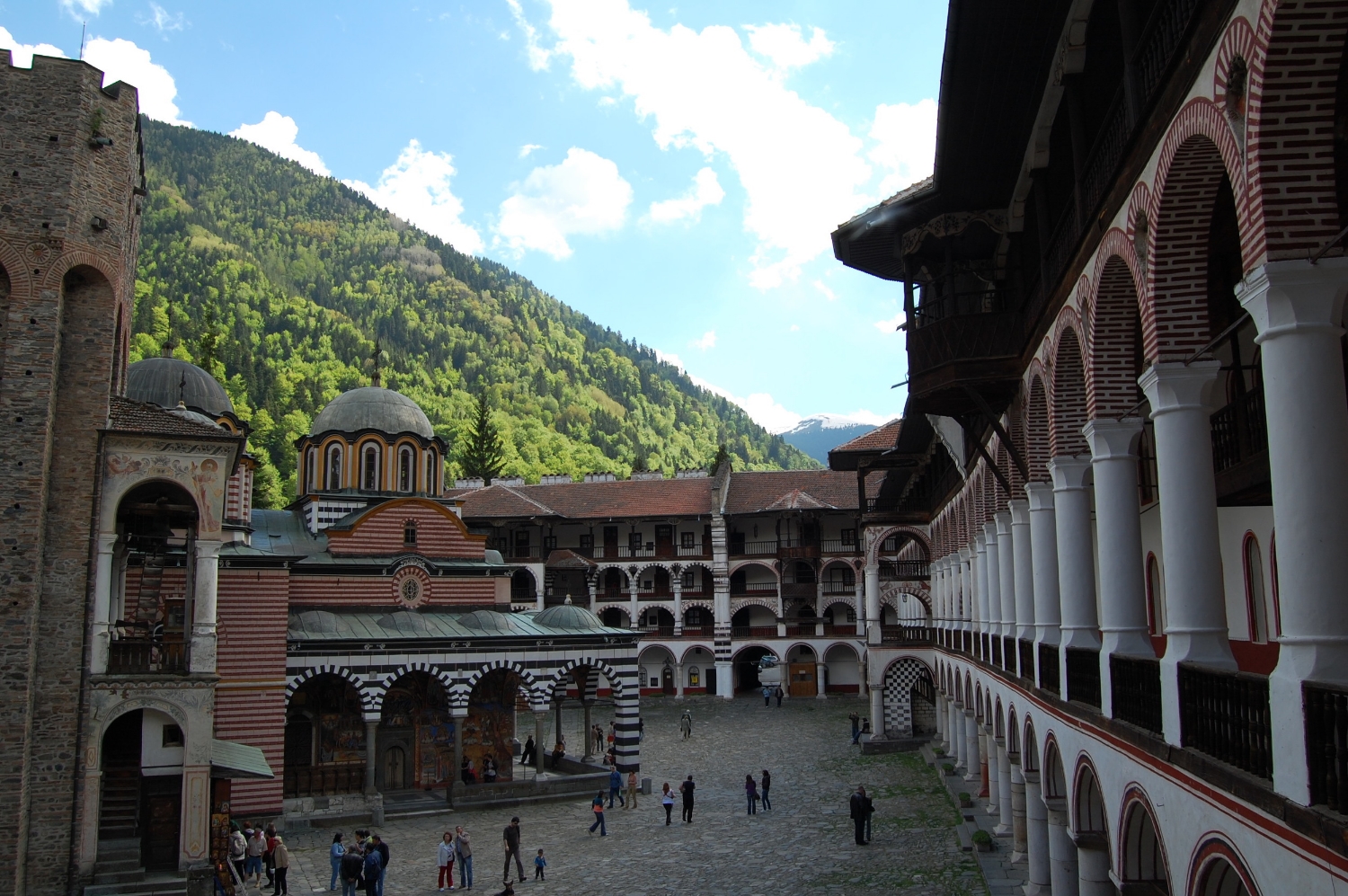
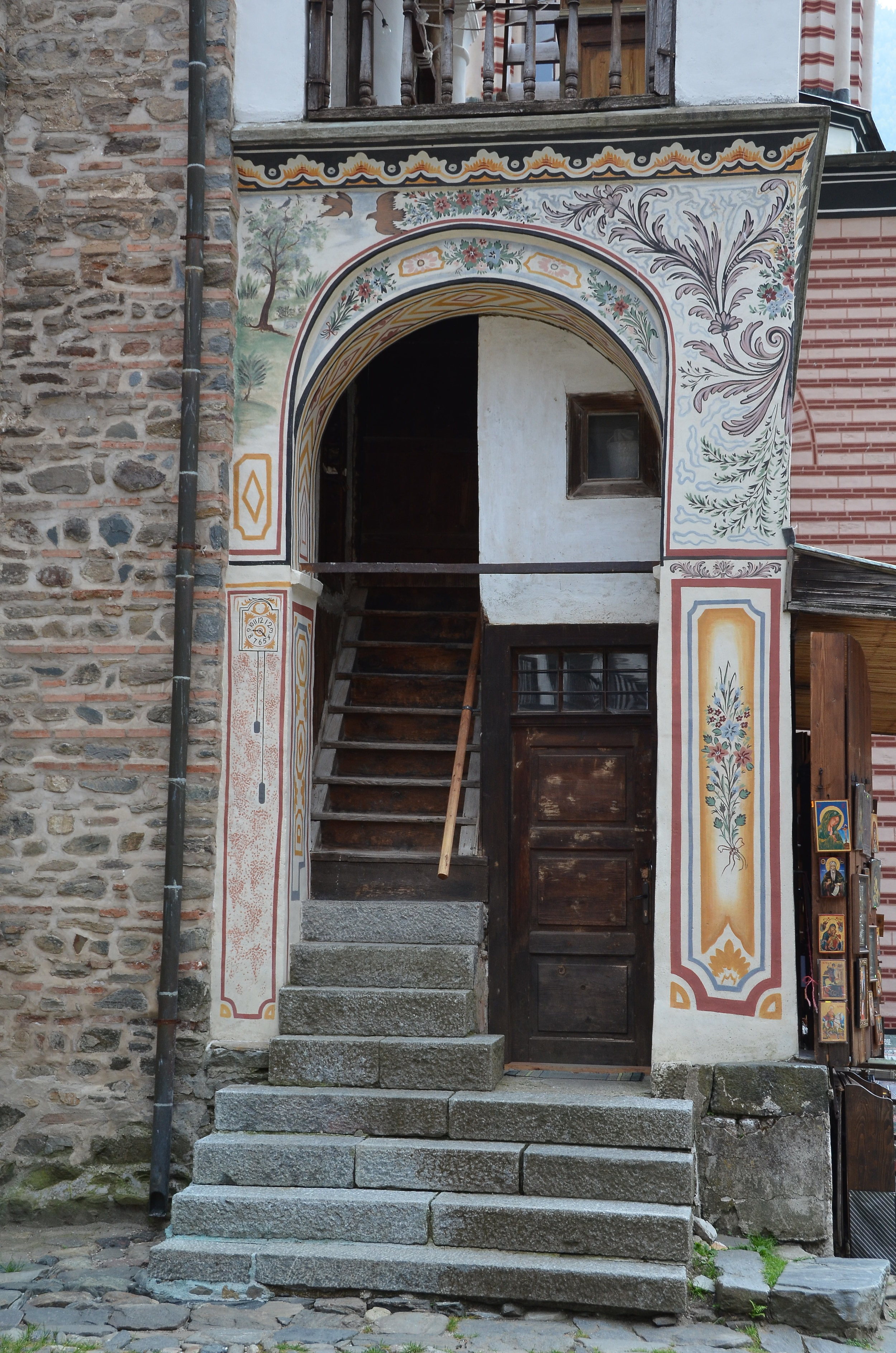

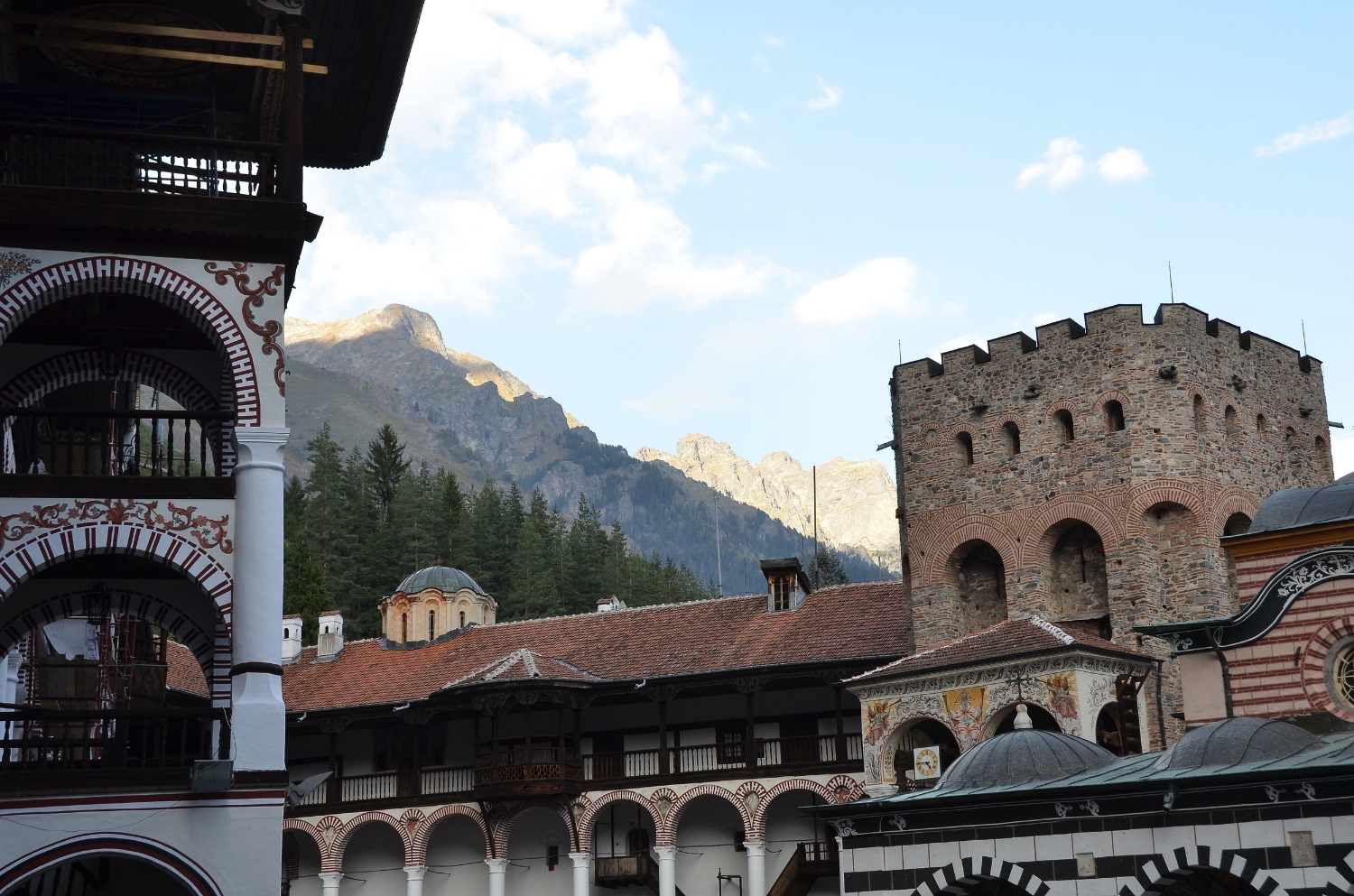
The Ottoman Turks invade mid-1300s
Not long after this fortification was built, Bulgaria was overtaken by the Ottoman Turks capturing the capital, Veliko Tarnovo, in 1393. They would rule Bulgaria and other lands for 500 years, subjugating the people, forcing the educated to flee, oppressing the Christian faith and trying to remove their national identity. Many monasteries were burned and closed, including Rila.
Re-building in mid-1400s -- Times change
Then in the mid 1400s three brothers (Josef, David, Teofan), all monks, decided to re-build the monastery and got permission from the Sultan in Constantinople to do so. There were close ties and support developed with St. Pantheleimon monastery on Mount Athos in 1455. The Sultan Mahomet II (ruled 1451-81) (Mehmet, Mehmed, Muhammad) established stability and was more permissive. In 1469 they were allowed to transfer the relics of St. John of Rila from Tarnovo to Rila Monastery. Paintings illustrate the foot procession through the countryside. This return restored hope and national identity in the Bulgarian people.
Revolution - 18th and 19th centuries, National Revival
Increased wealth, education, struggle, planning, negotiation, prayers, vision and determination as strong as the mountain rocks above their heads would lead to a sense of nation and revolution.
The Turks allowed sheep to be raised; wool merchants developed trade and earned money. They built expensive houses decorated with painted folk art and beautiful wood carvings by Bulgarians. People were proud of their work and heritage. They gave gifts to the monastery.
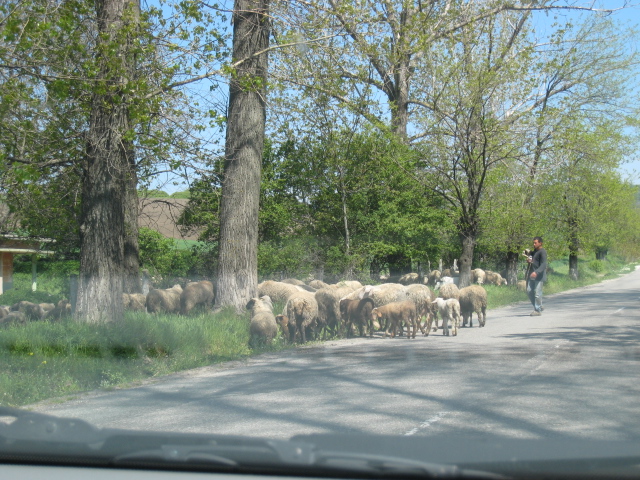
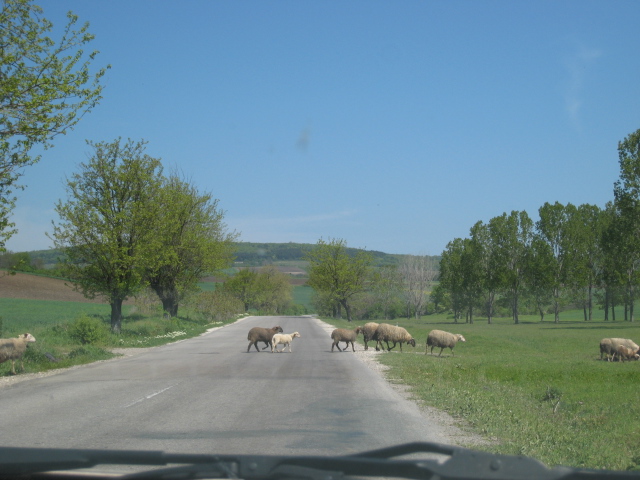
The monks traveled to Russia and other countries, making connections andreceiving gifts. A library was developed with gifts and books brought to be saved from burning. Scholars came to study the books. In addition to educated monks, writers came, the Tarnovo Literary School moved to Rila, church chanting developed, a printing press for wood blocks was installed, books were written, printed and bound here. It was a sanctuary for men and their ideas.
In 1762, Father Paisii (1722-73), who had lived on Mount Athos, wrote a three chapter Slavo-Bulgarian History honoring former Bulgarian leaders and the church . He was forbidden to print it, but many copies were hand copied and widely circulated. "The Lord has left only Rila Monastery to exist in our times...it is the duty of all Bulgarians to guard it, and to give alms to the sacred Rila Monastery." (See video link at end about Mt. Athos.)
The National Revival period had begun (18th and 19th centuries); the seeds of revolution were sprouting.
National Revival designed houses, Plovdiv, Bulgaria Photo © Evelyn Weliver
Beautiful carved wooden ceilings were in the rich National Revival homes. See wood-carving museum link at end. Photo © Del Weliver
New buildings and freedom
In 1816 construction began on the stone walled dormitories, about 22 meters high (65 feet). They were built in sections with the last one completed in 1847. A fire destroyed the wooden parts in 1833. Rebuilding began right away with all donations and work done by Bulgarians.
The monks decided the medieval church next to the tower was too small and construction began on the current Church of the Nativity in 1834. Pavel, master builder from Krimin was in charge. He brought ideas from Mount Athos, Greece where he had worked, and combined medieval and baroque elements.
Church of the Nativity, 1834, Rila Monastery, Bulgaria. Photo © Evelyn Weliver
Grave of Neofit Rilski (1793-1881), Rila Monastery, Bulgaria. Photo © Phyllis Weliver
A tremendous change developed when Neofit Rilski (1793-1881), a monk ordained in 1811 at Rila, entered the picture. He became the first head of Bulgaria's first secondary school Gabrovo, Bulgaria, 1835. He also wrote the first Bulgarian Grammar (1835), (Picture link) making the written Bulgarian language more accessible.
This is an example of an old, one room school in Tryavna, Bulgaria. Photo © Del Weliver
The first graders learned their letters in a sand box. Del and I write the Cyrillic alphabet. Photo © Del Weliver
Neofit Rilski returned to Rila to teach. His students became teachers and education spread. This important man became Abbot of Rila Monastery, 1860-1864, (Hegumen or Hieromonk). He translated the Bible into everyday Bulgarian because he understood the importance of people being able to read in their native language, thus binding them together as Bulgarians.
Other writers, such as Hristo Botev, wrote influential poetry that flamed nationalism. He also was a revolutionary leader, killed during battle.
A verse from "My Prayer" by Hristo Botev, translated by Peter Tempest
O God, in everyone inspire
An urgent love of liberty,
To give the utmost to the fight
Against the people’s enemies.
Revolutionaries may have met in taverns such as these or in private homes. The last two pictures are from the oldest tavern in Veliko Tarnovo, a former capital of Bulgaria.
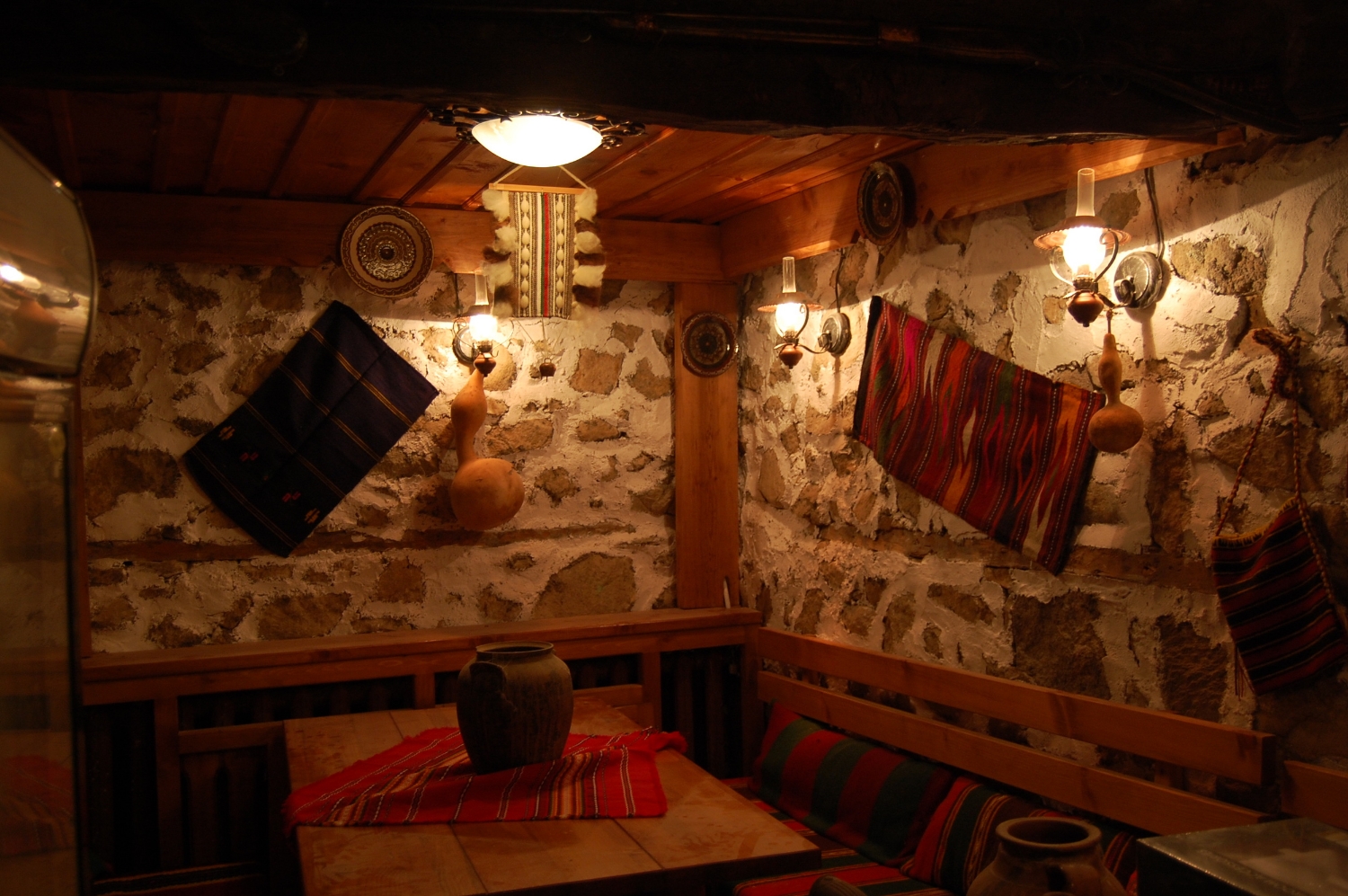
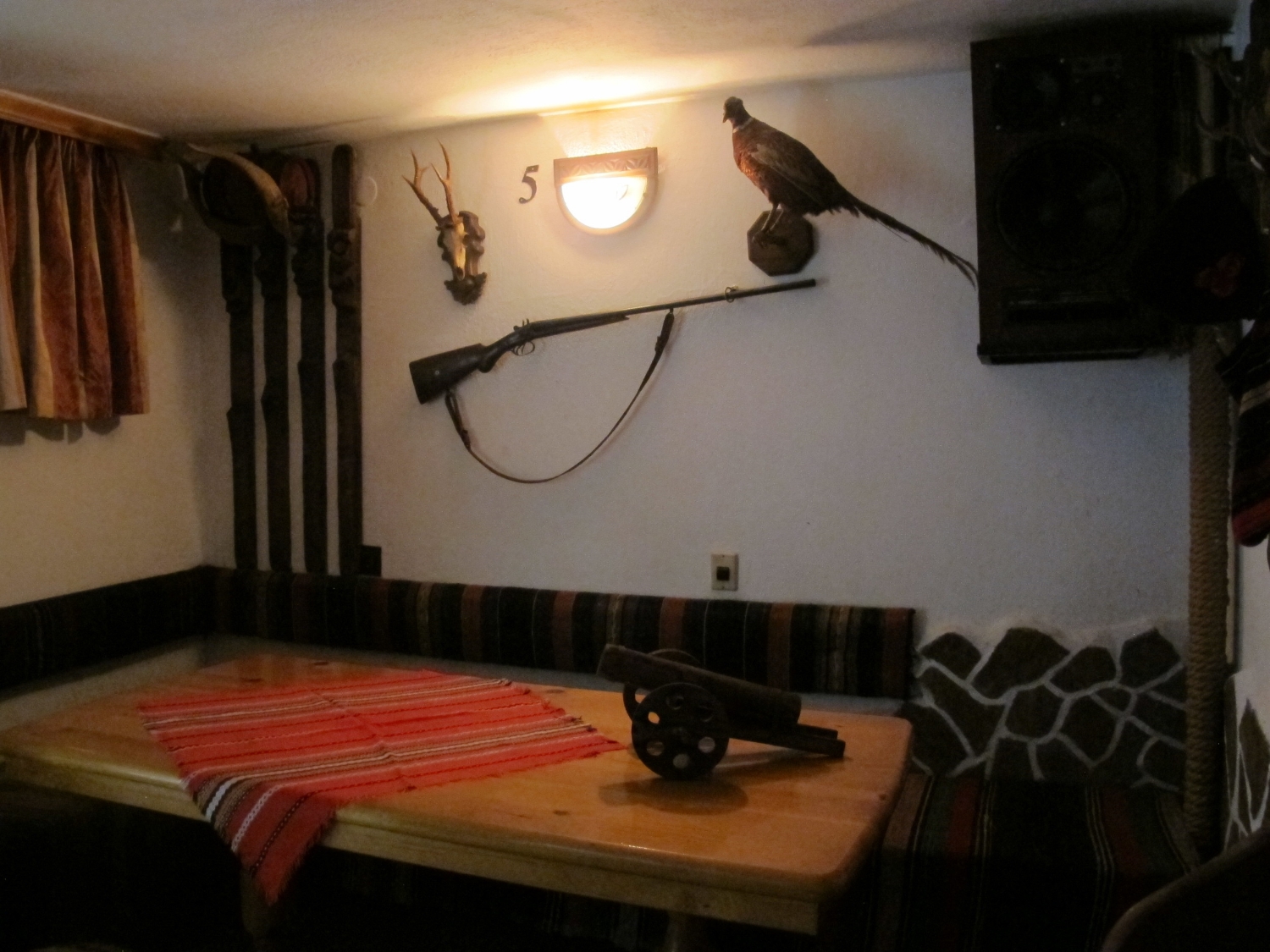
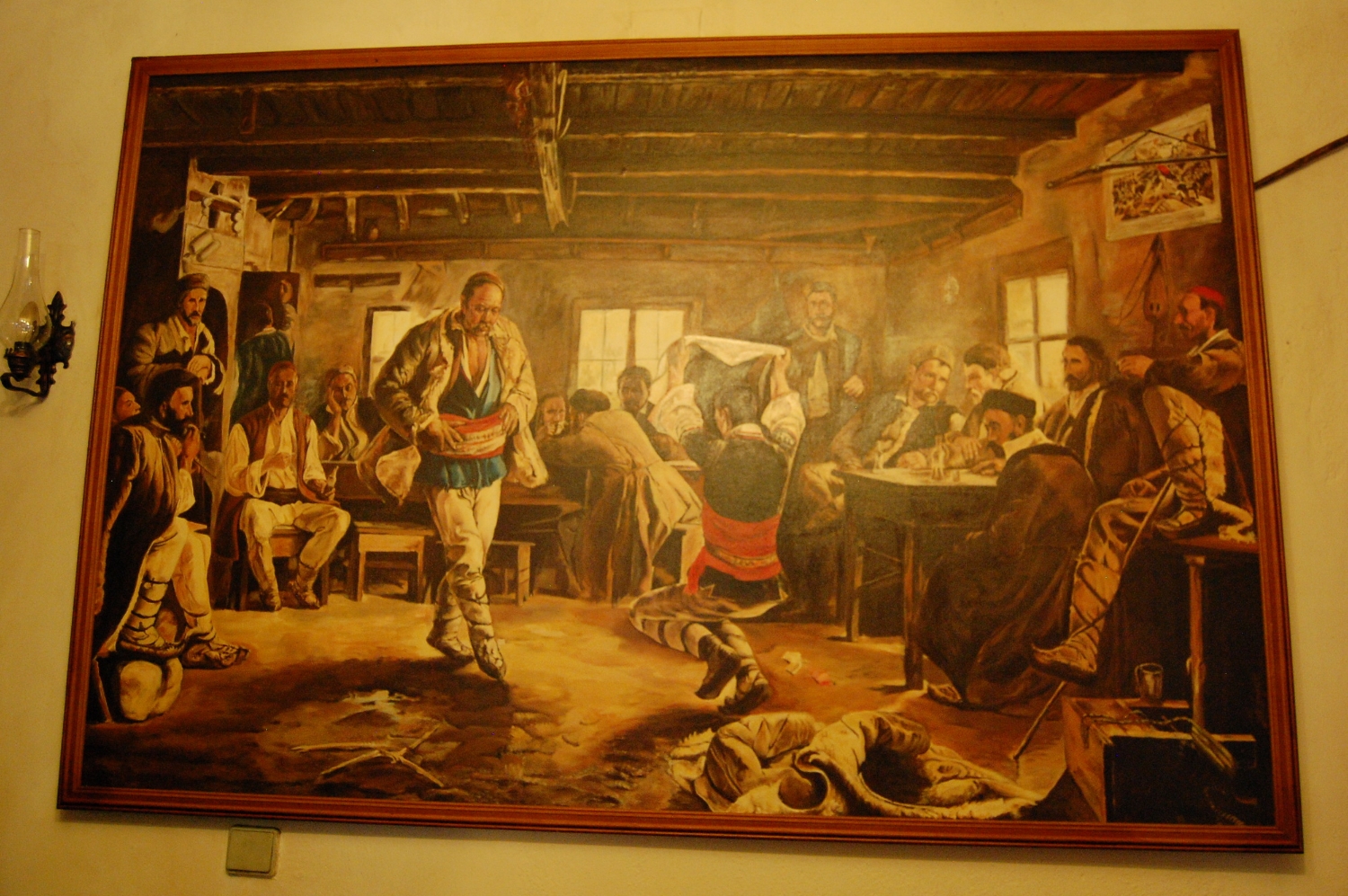
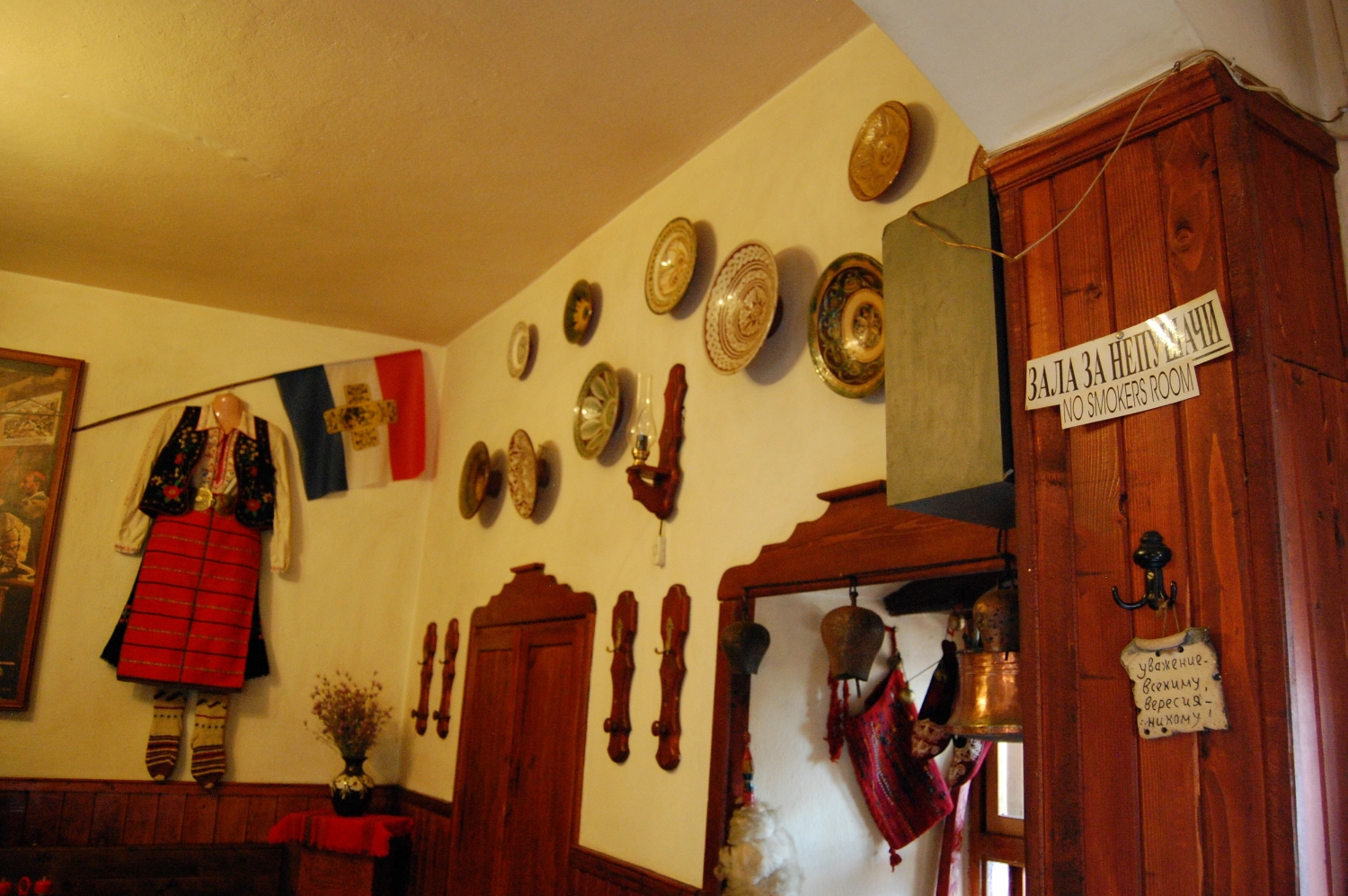
During this time, the leader of the revolution to overthrow the Ottoman Turks was born, Vasil Levski (1837-1873) He was also a monk and teacher. He was captured and hanged in 1873; the revolution work continued. There was a deadly uprising in 1876 when the Turks massacred perhaps 20,000 Bulgarians, many who had put down their weapons. News reports reached the world and help was offered. In 1878 at the Battle at Shipka Pass, Bulgarian and Russian soldiers defeated the Turks. Bulgaria was under its own rule, although it took several more years to complete the process. (1885)
-1878 Bulgaria finally had their own rulers after 500 years. Tsar Boris III ruled from 1918 until his death during World War II, perhaps from poison. His heart was buried in Rila Monastery.
-1946-1989 Bulgaria was part of the Eastern Bloc under Soviet Communist control with Bulgarian Communists in the government.
-1961 the government declares that Rila Monastery is a National Museum. They restored and preserved it.
-1983 it becomes an UNESCO World Heritage Site http://whc.unesco.org/en/list/216
-1991 Rila monastery is returned to the Holy Synod of the Bulgarian Orthodox Church
Bulgaria is now a democratic government with a president, parliament and prime minister. After 1989 they wrote a new constitution. In 2004 they joined NATO and in 2007 became a member of the European Union. Their currency is the Lev and it is tied to the Euro.
The empowering strengths of the Bulgarian people through tumultuous times have included: faith in God, close family ties, St. John of Rila, and Rila Monastery. By encouraging education, teaching about their history, preserving their culture and giving the people hope, Rila Monastery has preserved Bulgaria's sense of nationhood.
I find that when I visit Rila, I am experiencing much more than what I see with my eyes.
Part III will have pictures of the church and the courtyard. We will also go to lunch.
LINKS: Museum of Wood-Carving, Tryavna, Bulgaria http://bulgariatravel.org/en/object/111/muzej_rezbarstvo_tryavna
CBS News video about Mount Athos, Greece is excellent. Mount Athos is a secluded retreat for men and is very different from Rila that is open to all people.http://www.cbsnews.com/news/mt-athos-a-visit-to-the-holy-mountain/
References: Special thanks to Aleksandar Palichev, former Deputy Minister of Culture and Chief Engineer for Restoration of Monuments, and his translator, for sharing Bulgaria with us on many trips.
Also, resources as in Part One, plus Eyewitness Travel: Bulgaria. DK Publishing
Church of the Nativity, 1834, Rila Monastery, Bulgaria. Photo © Evelyn Weliver






